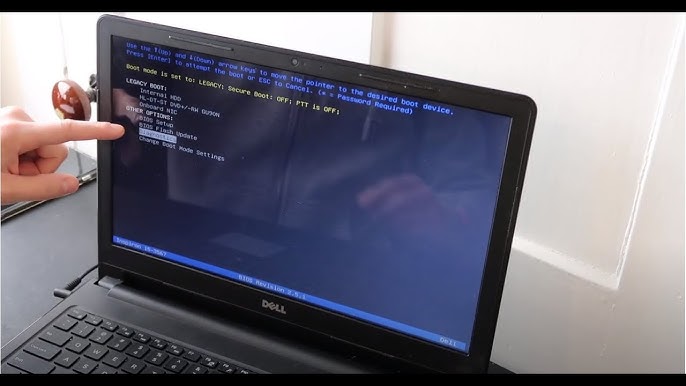The Basics
Before diving into more detailed troubleshooting, start with these fundamental steps:
-
Restart Your Computer:
- Use the restart option in the Start Menu. This can finalize any pending repairs and restart all system services.
-
Check for Blue Screen of Death (BSOD):
- If your laptop restarts with a BSOD, refer to the Dell Laptop Blue Screen page for specific solutions.
-
Force a Shutdown:
- Interrupt a reboot cycle by pressing and holding the power button until the laptop shuts off. Then, power it on again to reset any problematic settings.
-
Remove All Peripherals:
- Disconnect all external devices (flash drives, USB hubs, display cables, etc.), leaving only the charger connected.
-
Verify Battery Connection:
- Ensure the removable battery (if applicable) is properly seated and secured in the laptop.
-
Process Pending Windows Updates:
- Install any pending updates to resolve software issues and compatibility conflicts.
Possible Causes and Solutions
1. Problematic Settings
Incorrect settings can cause your laptop to restart unexpectedly.
-
Disable Fast Startup:
- Open a Run window by pressing Windows + R.
- Type
powercfg.cpland press Enter. - Click on "Choose what the power button does" on the left side.
- Select "Change settings that are currently unavailable" and uncheck "Turn on fast startup." Save the changes.
-
Use a Restore Point:
- Revert any unwanted changes by using a restore point to improve performance, especially if the laptop won't boot into Windows.
2. Faulty Power Input
Loose or damaged connections between the charger and the laptop can cause power interruptions.
-
Try a Different Charger:
- Test with another charger to see if the issue persists.
- Check if the laptop stays charging when moved. If not, wiggle the charger input to recreate the issue.
-
Inspect the Charger and Port:
- Look for bent pins or worn housing causing inconsistent connections. Replace the charger or cables if necessary.
3. Corrupt or Outdated Drivers
Old or corrupt drivers can lead to instability.
-
Check Device Manager for Errors:
- Press Windows Key + X, select Device Manager, and look for devices with a yellow caution icon.
-
Update Drivers via Windows Update:
- Go to Settings > Update & Security > Windows Update, and check for updates. View optional updates for additional drivers.
-
Use Dell SupportAssist:
- Download the latest drivers from Dell, which might be newer than Windows versions.
-
Uninstall Problematic Drivers:
- In Device Manager, right-click the problematic component, select Uninstall, and restart the computer to reinstall the current version.
4. Malware Infection
Malware can destabilize your system, causing restarts.
-
Scan with Antivirus Software:
- Use Windows Defender or third-party programs like Malwarebytes or ESET Online Scan.
-
Remove Detected Malware:
- Follow the recommendations to remove any threats and complete any necessary restarts.
5. Operating System Corruption
Corrupted OS files can cause frequent restarts.
-
Run System File Checker:
- Open Command Prompt, Powershell, or Windows Terminal. Type
sfc /scannowand press Enter.
- Open Command Prompt, Powershell, or Windows Terminal. Type
-
Consult Basic Windows Repair:
- Follow additional repair steps if the issue persists.
-
Reinstall Windows:
- Create a bootable flash drive from a known good computer, back up your data, and perform a clean install of Windows.
6. Bad Battery
Faulty batteries can cause unexpected shutdowns or restarts.
-
Run a Power Diagnostic:
- Use Dell SupportAssist or
powrcfgto check battery health. Replace the battery if needed.
- Use Dell SupportAssist or
-
Inspect for Battery Damage:
- Look for swelling or leaks, which can affect performance. Disconnect the battery and run the laptop on the charger to see if restarts stop.
7. Faulty Memory
RAM issues can lead to crashes.
-
Reseat RAM Modules:
- Remove and reinstall the RAM to ensure proper connection.
-
Run a RAM Diagnostic:
- Use Dell SupportAssist or Windows Memory Diagnostics. For a more thorough test, use memtest86.
-
Verify RAM Compatibility:
- Ensure recently upgraded RAM is compatible with your laptop. Replace any faulty memory modules.
Additional Resources
-
Dell Laptop Power Adapters and Batteries:
- Find compatible replacement parts backed by the VoltaGuru Quality Guarantee.
-
Professional Repair Services:
- If you're not confident in performing repairs, seek professional help.
Conclusion
By following these steps, you can diagnose and potentially fix the issue of your Dell laptop restarting. Start with the basics and systematically address each potential cause. For complex issues like motherboard damage or soldered RAM, consider professional repair services.

